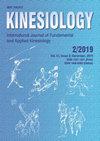9-11岁斯洛文尼亚儿童体育活动的社会和人口因素
IF 0.9
4区 医学
Q4 REHABILITATION
引用次数: 3
摘要
与儿童身体行为相关的因素对于理解他们身体活动的特征很重要。除了物理环境因素外,社会和人口因素也与体育活动水平有关。从随机选择的斯洛文尼亚小学随机选择669名儿童(9.9±0.8岁;48.8%的男孩)参加了这项研究。所有数据都是在2010年5月的一次测量中获得的。标准化问卷生活质量调查用于测量体育活动(PA)水平以及可能与其相关的社会和人口因素。结果表明,男孩的PA水平高于女孩(704±286分钟/周vs.617±268分钟/周;p<.001)。方差分析证实,父母具有较高社会经济地位(SES)的女孩的PA水平较高(p=0.018);在男孩中,根据SES,PA水平没有差异(p=.580)。在男孩(p=.047)和女孩(p=.021)中,如果他们全家都是任何体育俱乐部的成员,PA水平都会更高。然而,男孩(p=.648)或女孩(p=.132)的家庭结构与PA水平无关。在男孩中,双变量回归分析显示,与母亲的教育水平(r=.090)、家庭子女数量(r=.150)呈正相关,与孩子积极通勤上学有吸引力(r=.108)和孩子的同龄人积极通勤上学的态度(r=.129)呈负相关,而与担心孩子在上学途中会成为暴力或骚扰的受害者呈负相关(r=-0.097),双变量回归分析显示,与母亲的教育水平(r=.094)、孩子积极通勤上学有吸引力的态度(r=.092)和孩子的同龄人积极通勤上学的态度(r=.221)呈正相关,而与担心孩子在上学途中(r=-0.061)或在娱乐和体育设施中(r=-0.046)成为暴力或骚扰的受害者建立了负相关。根据双变量分析中的低相关性,我们得出结论,其他因素,如物理环境,可能与儿童的体育活动水平密切相关,在准备加强体育活动的干预措施时需要考虑到这一点。关键词:儿童、青少年、社会经济地位、积极通勤本文章由计算机程序翻译,如有差异,请以英文原文为准。
SOCIAL AND DEMOGRAPHIC FACTORS OF PHYSICAL ACTIVITY IN 9-11 YEARS OLD SLOVENIAN CHILDREN
Factors related to physical behaviour of children are important in understanding the characteristics of their physical activity. Apart from the factors of physical environment, social and demographical factors are also related to physical activity levels. Randomly selected 669 children (9.9±0.8 years; 48.8% boys) from randomly selected Slovenian elementary schools participated in this study. All data were obtained during a single measurement in May 2010. The standardized questionnaire The Quality of Life Survey was used to measure physical activity (PA) levels as well as social and demographic factors which could be associated with it. The results indicated higher PA levels in boys than in girls (704±286 min/week vs. 617±268 min/week; p<.001). The analysis of variance confirmed higher PA levels in girls with parents of a higher socioeconomic status (SES) (p=.0018); in boys, there were no differences in PA levels according SES (p=.580). In both the boys (p=.047) and girls (p=.021) PA levels were higher if their whole family were members of any sport club. However, family structure was not related to PA levels in either boys (p=.648) or girls (p=.132). In boys, the bi-variate regression analysis showed a positive correlation with mother’s educational level (r=.090), with the number of children in the family (r=.150), with the child’s attitude that active commute to school is attractive (r=.108) and that child’s peers actively commute to school (r=.129), whereas a negative correlation was obtained with fear the child would become a victim of violence or harassment on the way to school (r=-.097). In girls, bi-variate regression analysis showed a positive correlation with mother’s educational level (r=.094), with the child’s attitude that active commute to school is attractive (r=.092) and that child’s peers actively commute to school (r=.221), whereas a negative correlation was established with fear the child would become a victim of violence or harassment on the way to school (r=-.061) or at recreational and sporting facilities (r=-.046). According to low correlations in bi-variate analysis, we conclude that other factors, such as, for example, physical environment, might be strongly related to physical activity levels in children and need to be taken into account when preparing interventions for physical activity enhancement. Key words: children, adolescents, socioeconomic status, active commute
求助全文
通过发布文献求助,成功后即可免费获取论文全文。
去求助
来源期刊

Kinesiology
REHABILITATION-SPORT SCIENCES
CiteScore
1.90
自引率
8.30%
发文量
16
审稿时长
>12 weeks
期刊介绍:
Kinesiology – International Journal of Fundamental and Applied Kinesiology (print ISSN 1331- 1441, online ISSN 1848-638X) publishes twice a year scientific papers and other written material from kinesiology (a scientific discipline which investigates art and science of human movement; in the meaning and scope close to the idiom “sport sciences”) and other adjacent human sciences focused on sport and exercise, primarily from anthropology (biological and cultural alike), medicine, sociology, psychology, natural sciences and mathematics applied to sport in its broadest sense, history, and others. Contributions of high scientific interest, including also results of theoretical analyses and their practical application in physical education, sport, physical recreation and kinesitherapy, are accepted for publication. The following sections define the scope of the journal: Sport and sports activities, Physical education, Recreation/leisure, Kinesiological anthropology, Training methods, Biology of sport and exercise, Sports medicine and physiology of sport, Biomechanics, History of sport and Book reviews with news.
 求助内容:
求助内容: 应助结果提醒方式:
应助结果提醒方式:


